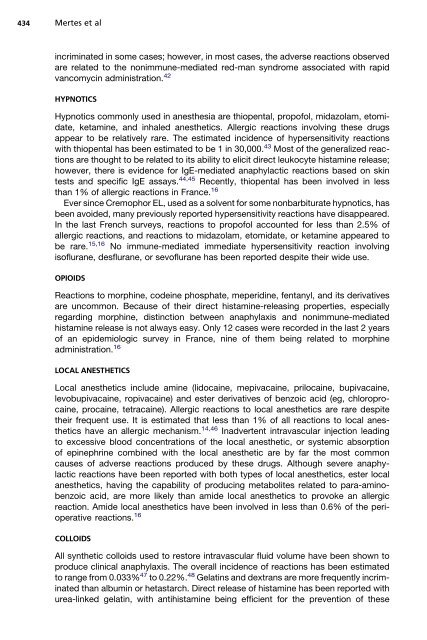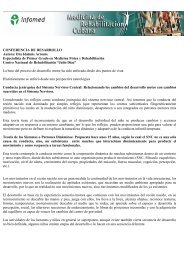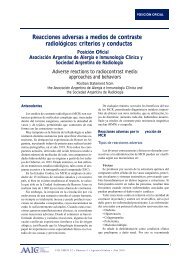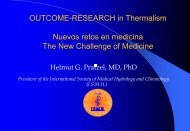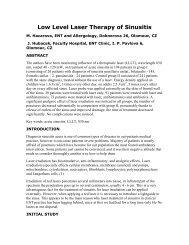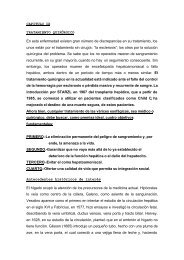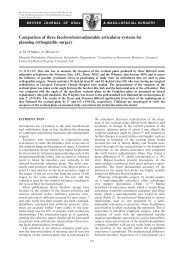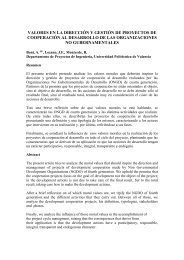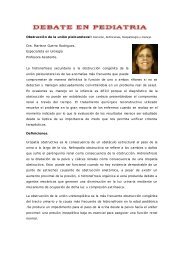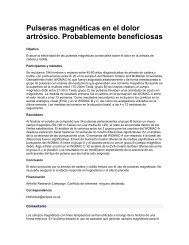Perioperative Anaphylaxis
Perioperative Anaphylaxis
Perioperative Anaphylaxis
You also want an ePaper? Increase the reach of your titles
YUMPU automatically turns print PDFs into web optimized ePapers that Google loves.
434<br />
Mertes et al<br />
incriminated in some cases; however, in most cases, the adverse reactions observed<br />
are related to the nonimmune-mediated red-man syndrome associated with rapid<br />
vancomycin administration. 42<br />
HYPNOTICS<br />
Hypnotics commonly used in anesthesia are thiopental, propofol, midazolam, etomidate,<br />
ketamine, and inhaled anesthetics. Allergic reactions involving these drugs<br />
appear to be relatively rare. The estimated incidence of hypersensitivity reactions<br />
with thiopental has been estimated to be 1 in 30,000. 43 Most of the generalized reactions<br />
are thought to be related to its ability to elicit direct leukocyte histamine release;<br />
however, there is evidence for IgE-mediated anaphylactic reactions based on skin<br />
tests and specific IgE assays. 44,45 Recently, thiopental has been involved in less<br />
than 1% of allergic reactions in France. 16<br />
Ever since Cremophor EL, used as a solvent for some nonbarbiturate hypnotics, has<br />
been avoided, many previously reported hypersensitivity reactions have disappeared.<br />
In the last French surveys, reactions to propofol accounted for less than 2.5% of<br />
allergic reactions, and reactions to midazolam, etomidate, or ketamine appeared to<br />
be rare. 15,16 No immune-mediated immediate hypersensitivity reaction involving<br />
isoflurane, desflurane, or sevoflurane has been reported despite their wide use.<br />
OPIOIDS<br />
Reactions to morphine, codeine phosphate, meperidine, fentanyl, and its derivatives<br />
are uncommon. Because of their direct histamine-releasing properties, especially<br />
regarding morphine, distinction between anaphylaxis and nonimmune-mediated<br />
histamine release is not always easy. Only 12 cases were recorded in the last 2 years<br />
of an epidemiologic survey in France, nine of them being related to morphine<br />
administration. 16<br />
LOCAL ANESTHETICS<br />
Local anesthetics include amine (lidocaine, mepivacaine, prilocaine, bupivacaine,<br />
levobupivacaine, ropivacaine) and ester derivatives of benzoic acid (eg, chloroprocaine,<br />
procaine, tetracaine). Allergic reactions to local anesthetics are rare despite<br />
their frequent use. It is estimated that less than 1% of all reactions to local anesthetics<br />
have an allergic mechanism. 14,46 Inadvertent intravascular injection leading<br />
to excessive blood concentrations of the local anesthetic, or systemic absorption<br />
of epinephrine combined with the local anesthetic are by far the most common<br />
causes of adverse reactions produced by these drugs. Although severe anaphylactic<br />
reactions have been reported with both types of local anesthetics, ester local<br />
anesthetics, having the capability of producing metabolites related to para-aminobenzoic<br />
acid, are more likely than amide local anesthetics to provoke an allergic<br />
reaction. Amide local anesthetics have been involved in less than 0.6% of the perioperative<br />
reactions. 16<br />
COLLOIDS<br />
All synthetic colloids used to restore intravascular fluid volume have been shown to<br />
produce clinical anaphylaxis. The overall incidence of reactions has been estimated<br />
to range from 0.033% 47 to 0.22%. 48 Gelatins and dextrans are more frequently incriminated<br />
than albumin or hetastarch. Direct release of histamine has been reported with<br />
urea-linked gelatin, with antihistamine being efficient for the prevention of these


